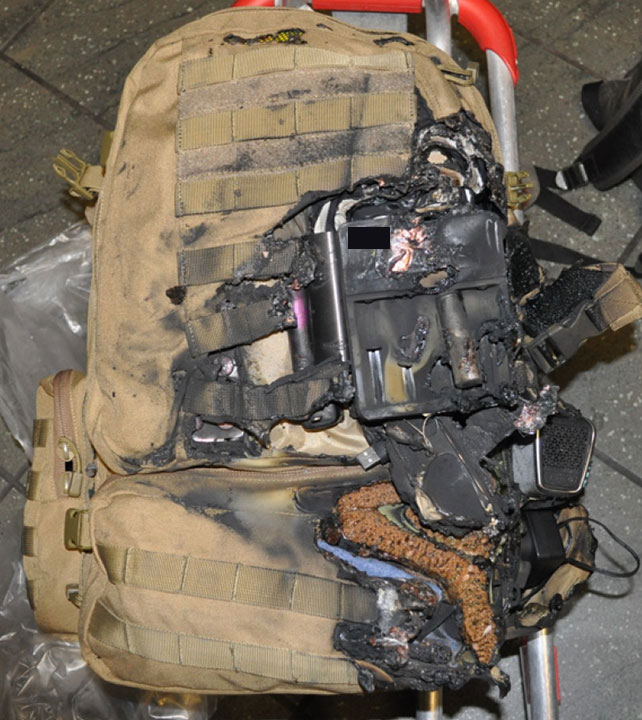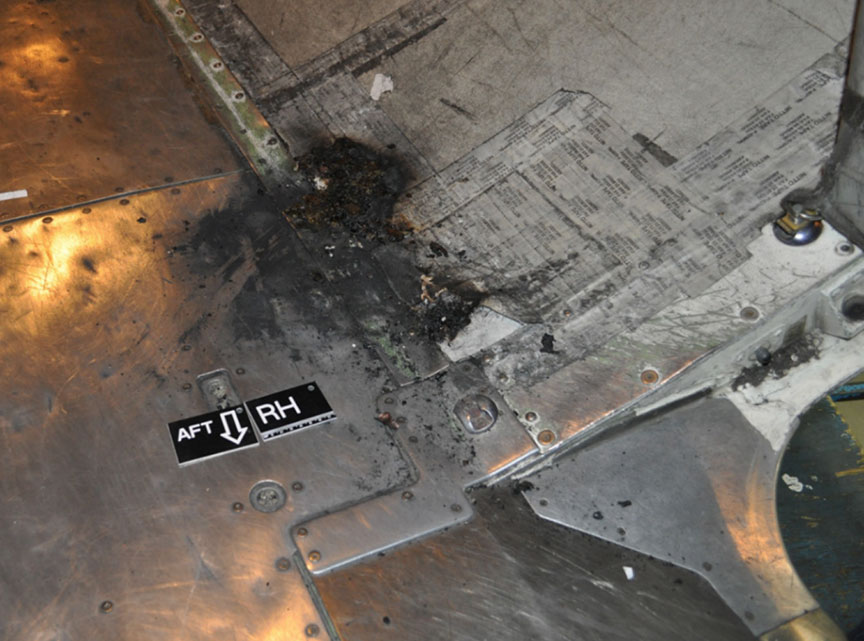Baggage compartment fire
WestJet
Boeing 737-700, C-GWJT
Calgary, Alberta
The Transportation Safety Board of Canada (TSB) investigated this occurrence for the purpose of advancing transportation safety. It is not the function of the Board to assign fault or determine civil or criminal liability. This report is not created for use in the context of legal, disciplinary or other proceedings. See Ownership and use of content. Masculine pronouns and position titles may be used to signify all genders to comply with the Canadian Transportation Accident Investigation and Safety Board Act (S.C. 1989, c. 3).
History of the flight
The Boeing 737-700 (registration C-GWJT, serial number 40338), operated by WestJet as flight 113 (WJA113), was on a day instrument flight rules flight from Calgary International Airport (CYYC), Alberta, to Vancouver International Airport (CYVR), British Columbia, with 2 flight crew members, 3 cabin crew members, and 53 passengers on board. The aircraft departed from Runway 35L at CYYC at approximately 0639.Footnote 1 The captain was the pilot flying, and the first officer was the pilot monitoring.
While the aircraft was climbing through 9000 feet above sea level, at 0641:10, a lower aft cargo fire warning light illuminated. The flight crew immediately followed the CARGO FIRE procedures published in the company's 737NG Quick Reference Handbook (QRH). The CARGO FIRE DISCH switch was activated, and 1 cargo fire extinguishing bottle was discharged.
At 0646, the flight crew declared a MAYDAY emergency and initiated a return to CYYC. Ten minutes later, the aircraft landed on Runway 35R at CYYC and exited onto Taxiway Delta. After clearing the active runway, the aircraft stopped on the taxiway and was inspected by airport rescue and firefighting (ARFF) services. No visual signs of fire were noted, and no hot spots were detected by infrared camera imaging.
In accordance with the QRH, the flight crew informed ground personnel not to open any cargo doors until all passengers and crew had exited the aircraft.Footnote 2 The aircraft was cleared to taxi back to the gate, where the passengers and crew were deplaned. After all passengers were off the aircraft, ARFF and WestJet ground handling personnel opened the lower aft baggage compartment.
One passenger bag, found face-down near the cargo compartment door opening, showed signs of fire damage (Figure 1).
Cargo hold damage
The fire damage was isolated to the individual bag. Minor thermal damage was found to the cargo compartment's fire-resistant liner near the bag. The fire did not penetrate the cargo liner or aluminum floor structure and was contained to an area of approximately 24 inches by 24 inches (Figure 2). There was no additional damage to any of the surrounding bags. The burnt bag was offloaded and segregated, and then all other passenger baggage were offloaded.
Cockpit voice recorder and flight data recorder
As per regulations, the aircraft was equipped with a cockpit voice recorder and a flight data recorder, which were removed and sent to the TSB Engineering Laboratory in Ottawa, Ontario. The data indicated that, other than the lower aft cargo fire warning, the crew did not receive any additional warnings or alarms. The crew's actions were carried out in accordance with the QRH and company standard operating procedures.
Aircraft information
Records indicate that the aircraft was certified, equipped, and maintained in accordance with existing regulations and approved procedures. The Boeing 737-700 (also referred to as 737-7CT) was manufactured by Boeing Commercial Airplanes in 2011. It is a twin-engine, medium-range, turbofan airliner with 140 passenger seats and a cruise speed of about 430 knots.
Passenger bag
The passenger whose bag caught fire flew frequently for business purposes and was aware of WestJet's policies with respect to restricted items in checked baggage. The passenger packed his bag, a tactical-style nylon backpack, on the evening of 13 June 2018 and inadvertently packed 2 spare lithium-ion batteries for his e-cigarette,Footnote 3 in the charger, in the front pocket of the bag. The pocket also contained a dry herb vaporizer, a portable speaker, and USB cables.
On the morning of 14 June 2018, the passenger arrived at the airport and checked his bag in. He took his e-cigarette and 2 other lithium-ion batteries into the passenger cabin, as required by WestJet's policy on e-cigarettes.Footnote 4Footnote 5
The checked bag proceeded through the passenger baggage security screening and was loaded into the aircraft's lower aft baggage compartment, while still containing the 2 spare lithium-ion batteries.
Restricted items
Air carriers in Canada are responsible for complying with the Transportation of Dangerous Goods Regulations (TDGR) with respect to checked baggage. In February 2016, Transport Canada issued a Transportation of Dangerous Goods Safety AdvisoryFootnote 6 alerting air operators, passengers and crew of the safety risks associated with e-cigarettes and recommended that e-cigarettes, including any associated lithium-ion batteries, only be carried in the cabin.
The information on WestJet's website relating to restricted items states that e-cigarettes, including associated lithium-ion batteries, “Must be carried in carry-on baggage only,”Footnote 7 and operator approval is required. The website details the restrictions as follows:
E-Cigarettes.
- E-Cigarettes are permitted in carry-on baggage but not for use on board the aircraft due to the high temperatures they generate.
- Batteries must be removed to eliminate the risk of unintentional activation and individually protected so as to prevent short circuits.Footnote 8
To protect batteries, exposed terminals can be taped over, each individual battery can be in a protective pouch or separate plastic bag, or batteries can be in their original retail packaging.
Checked-baggage screening
All passenger baggage is subject to security screening, which is conducted by the Canadian Air Transport Security Authority (CATSA). However, this screening is designed to detect explosive materials that are a threat to aviation safety rather than batteries and other dangerous goods.
CATSA's checked-baggage screening machines do not automatically detect dangerous goods; however, if possible dangerous goods are discovered during the screening process, CATSA will perform additional checks and follow up with air carriers. For example, if CATSA screening officers are presented with an X-ray image of a container that could contain dangerous goods, they are required to send the bag for a physical search. If a dangerous good is discovered during the search, CATSA requires the screening officers to inform an air carrier representative, who will determine if the goods can be transported on the aircraft.
Lithium-ion battery
The proliferation of lithium-ion batteries in personal electronic devices has resulted in an increase in aviation cargo and passenger baggage events involving smoke, fire, extreme heat, or explosion. As at 02 May 2018, the United States Federal Aviation Administration has recorded 206 air/airport incidents involving lithium-ion batteries carried as cargo or baggage since 20 March 1991.Footnote 9
The TSB Engineering Laboratory conducted an analysis of the lithium batteries and electrical components contained in the passenger baggage.Footnote 10
The engineering report concluded that 1 battery in the charger experienced a thermal runaway and the interior material of the battery was completely burnt out. The thermal runaway was likely caused by external damage. The investigation could not determine if the damage occurred before the battery arrived at the airport or during baggage handling.
Safety messages
Lithium-ion batteries are subject to the Transportation of Dangerous Goods Regulations. Transport Canada's safety advisory on the transportation of electronic cigarettes on aircraft exists to prevent the transportation of lithium-ion batteries in checked baggage, which can pose a hazard to the safety of aircraft.
In this occurrence, even though the passenger was aware of the restrictions on lithium-ion batteries, the checked baggage was not identified as containing dangerous goods before being loaded into the cargo hold. When this type of responsibility is shared among passengers, air carriers, and security screening authorities, no one agency or individual is in a position to ensure that the contents of baggage comply with an air carrier's requirements related to restricted items.
This concludes the TSB's limited-scope investigation into this occurrence. The Board authorized the release of this investigation report on . It was officially released on .

